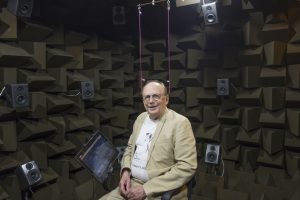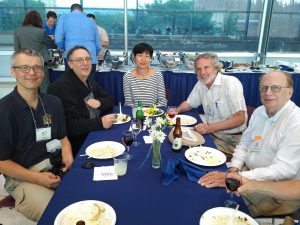 This is a summary of the International Conference on Audio Display held this year at Pennsylvania State University, June 20-23, 2017.
This is a summary of the International Conference on Audio Display held this year at Pennsylvania State University, June 20-23, 2017.
ICAD started in 1992 as a conference. When they later decided to incorporate as a non-profit organization they registered that as The International Community for Audio Display (also abbreviated ICAD).
The focus of the organization is the use of audio in communication, especially non-speech audio, though some projects do involve speech. It is not about music as entertainment, though some ICAD researchers use their skills also to create music. There was a concert at this year’s ICAD conference in which compositions were presented, created by the tools of auditory display, that rivaled the quality of music I have heard at major conferences just devoted to electro-acoustic music.
What is the range of ICAD topics?
The range is broad so I can only highlight examples. My mentioning one paper is not intended to promote or emphasize that particular paper, just to cite it as one example.
All of the ICAD 17 papers are now online and I encourage visitors to this blog who are interested in these topics to explore them. All ICAD conference proceedings are hosted at Georgia Tech University.
The broadest listing of the ICAD 17 papers (listed by title) can be seen at:
https://smartech.gatech.edu/handle/1853/58348/browse?type=title
But the site can also be searched narrowly by author or topic. Furthermore, the proceedings of all earlier conferences can also be searched and read via the same database, a very well- organized database.
Broad topics:
SONIFICATION OF DATA
This has been a fundamental theme of ICAD since its inception. We know that data can be visually represented in many ways, and designers like Edward Tufte have shown that the method of visual representation used plays a big role in one’s interpretation of the data. Auditory display researchers have worked on any number of projects to see if representing data aurally can aid in understanding datasets either singly or in conjunction with visual display. This work has only been going on for 25 years or so, so there is much to be learned and many experiments to do.
A few example papers from ICAD 17 that deal with this topic are:
Human and Machine Listening of Seismic Data
Illustrating Trends in Nitrogen Oxides Across the United States Using Sonification
madBPM: Musical and Auditory Display for Biological Predictive Modeling
Progress Toward Sonifying Napoleon’s March and Fluid Flow Simulations Through Binaural Horizons
Solar System Sonification: Exploring Earth and Its Neighbors Through Sound (A very popular presentation with the audience.)
Again, my apologies for not listing every paper in this summary. Please go to the proceeding page and read all of the topics and papers. There are so many and some even touch on more than one topic area.
ALERTS AND ASSISTIVE TECHNOLOGIES
There are often medical situations where sound is considered an aid to doctors or patients.
A couple of papers in this year’s conference that dealt with that were:
Did You Feel That? Developing Novel Multimodal Alarms for High Consequence Clinical Environments
Alarm sounds are also an important area where making good decisions can lead to good outcomes. As it happens, the day that the following paper was presented, USA Today (a paper given out free in some of the conference hotels) featured an accident where a driver in a “self-driving” Tesla car was killed in an accident after ignoring 7 visual warnings and 6 auditory ones:
Auditory and Head-Up Displays for Eco-Driving Interfaces
This paper led to a lengthy discussion among the participants about auditory signals in driving and aviation.
SOUND ENVIRONMENTS

The effectiveness of sound can depend on how it is heard. Monaural speaker? Stereo speaker? Binaural headphones? A surround-sound environment? etc. The first day of the conference I attended a four hour workshop: Tutorial on Higher Order Ambisonics and Demonstration of the Auralization and Reproduction of Acoustic Sound Fields presented by Penn State researchers, Mathew Neal and Nicholas Ortega. I don’t think this workshop information is so far included in the proceedings but they did hand out technical papers so one could do a search on the names in Google. Some of this is very technical so I urge anyone looking to work in this field to take lots of math. I was able to follow along but it was a struggle since my math studies were so long ago. The picture above shows me sitting in the “sweet spot” in Penn State’s highly sophisticated Ambisonics lab which has 32 speakers set inside an anechoic chamber. Sound was presented to me that was localized to various spots around my body.
Most of the main conference papers did not deal so much with sound presentation systems as at some other conferences. Someone looking for a career in this field should think about graduate study in the field of acoustics.
SOUND PERCEPTION
Sound can be used more effectively if we understand how humans relate to it. This is an area that is often associated with perceptual psychology, another good career area. A couple of sample papers presented from that field of study were:
Evaluating Two Ways to Train Sensitivity to Echoes to Improve Echolocation
SOUND IN DESIGN
In the past, conference papers presented sound design ideas for various products. These design considerations can be specific to a device or game, or relate to a general approach. Three examples from ICAD 17 are:
EchoExplorer: A Game App for Understanding Echolocation and Learning to Navigate Using Echo Cues
Conclusion
I am sorry I cannot comment on all of the papers and topics. They were all very interesting and held me riveted to my chair. There were also a few demonstrations set up in another building that I did not get to see (as I didn’t want to miss any papers). There was also a poster session one evening where young researchers (generally) showed additional research. These were good, too.
 ICAD has been going now for 25 years. It was founded by Gregory Kramer (President 1992-1997 and an Emeritus President) who was not able to attend this year. There has been a total of seven Presidents in the 25 years. Five were able to attend ICAD 2017 though one, Bruce Walker (2006-2011), had to leave before the picture (left) was taken during the final banquet.
ICAD has been going now for 25 years. It was founded by Gregory Kramer (President 1992-1997 and an Emeritus President) who was not able to attend this year. There has been a total of seven Presidents in the 25 years. Five were able to attend ICAD 2017 though one, Bruce Walker (2006-2011), had to leave before the picture (left) was taken during the final banquet.
Left to right are:
— Matti Gröhn (2003-2006, but who has only missed one conference in the entire existence of ICAD so he is also Emeritus)
— David Worrall, the current President who is also head of audio studies at Columbia College, Chicago.
— The woman next to David is his wife.
— Jim Ballas (1997-2000), now retired I believe, who preceded me as President.
— Eric Somers (2000-2003), your audio penguin.
Note our plates are empty but our glasses/bottles are full. I am not sure what that says.
Next summer (exact dates to be announced) ICAD 2018 will be held at Michigan Technological University in Houghton, Michigan, way up in the Upper Peninsula of Michigan. This breaks a recent trend of having one conference in the U.S. followed by another outside the U.S., but speaking as someone whose mother was born in Houghton, Michigan’s “copper country,” as they call it, is almost its own country. If you go be sure to eat pasties, brought there by Cornish copper miners. I occasionally order some from Houghton and have them shipped to me on dry ice.
Leave a Reply